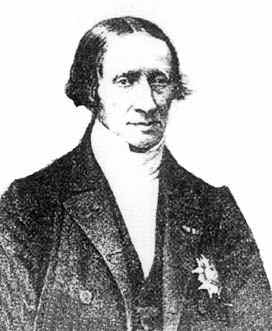


 تاريخ الرياضيات
تاريخ الرياضيات
 الرياضيات في الحضارات المختلفة
الرياضيات في الحضارات المختلفة 
 الرياضيات المتقطعة
الرياضيات المتقطعة
 الجبر
الجبر
 الهندسة
الهندسة 
 المعادلات التفاضلية و التكاملية
المعادلات التفاضلية و التكاملية 
 التحليل
التحليل
 علماء الرياضيات
علماء الرياضيات |
Read More
Date: 14-7-2016
Date: 19-7-2016
Date: 14-7-2016
|
Born: 6 October 1784 in Varzy, France
Died: 18 January 1873 in Paris, France

Charles Dupin's father was Charles-André-Dupin and his mother was Cathérine Agnès Dupin. In fact Dupin was both her married and maiden name. Charles' father was a lawyer and Charles himself was brought up in Nivernais, the region of his birth. Nivernais was not part of the French crown when he was born there, being owned from 1659 by Cardinal Mazarin and his descendants until 1790 when it became the département of Nièvre. Charles was the middle of the three sons of his parents; his older brother André also achieved fame in his profession as a lawyer.
Dupin was educated at the École Polytechnique in Paris, where he learnt geometry from Monge. While an undergraduate he made his famous discovery of what are called today 'Dupin's cyclides' guided in this work by Monge. He graduated in 1803 and then became a naval engineer. He often went on long sea voyages which resulted in his publications being much delayed. After being assigned to duties in Antwerp, Genoa and then Toulon, he was sent to Corfu in 1807 to take charge of the damaged naval arsenal there.
While in Corfu he carried out his naval engineer's duties of repairing the port, but he also carried out tasks relating to his scientific interests. He was appointed as secretary to the Ionian Academy which had been founded only a short time before and he undertook deep research on mathematical topic, in particular studying the differential geometry of surfaces, and applied mechanics where he investigated the resistance of materials.
After three years in Corfu he set out to return to France but, while passing through Pisa, he was taken ill. It took him a while to recover from the illness, but Dupin was not idle while recovering in Pisa. Rather he worked on this occasion on preparing for publication the writings of a friend who had died. In 1813 he was in Toulon, and there he set up a maritime museum which was highly influential in the way that maritime museums were organised.
Also in 1813 Dupin published his Développments de géométrie which [1]:-
... contains many contributions to differential geometry, notably the introduction of conjugate and asymptotic lines on a surface ...
Other contributions to differential geometry which occur in this work include his invention of the 'Dupin indicatrix' which gives an indication of the local behaviour of a surface up to the terms of degree two.
The year 1813 saw Dupin elected to the Institut de France, the new organisation set up to replace the Académie des Sciences after the French Revolution. With the reestablishment of the Académie des Sciences, Dupin was elected to that body in 1818.
Dupin was appointed professor at Conservatoire des Arts et Métiers in Paris in 1819. He held this post until 1854 and he gave many public lectures on the applications of mathematics and mechanics to industry. These lectures proved extremely popular, mainly since Dupin was an exceptional lecturer. But he not only had an academic life, publishing further important works on the applications of differential geometry to industry and the arts, but he also took a major part in politics from 1828. In that year he was elected as a deputy for Tarn, a département in southern France.
In 1830, at the age of 45, Dupin married Rosalie Anne Joubert. His political career continued and his expertise as a naval engineer clearly stood him in good stead when he was appointed as minister of maritime affairs in 1834. Four years later he became a peer and in 1852 he was appointed to the Senate. Struik writes in [1] that Dupin:-
... tirelessly encouraged the establishment of schools and libraries, the founding of savings banks, the construction of roads and canals, and the use of steam power.
As well as the honour of election to the Institut de France and the Académie des Sciences which we referred to above, he was also honoured with election to the Académie des Sciences Morales et Politique in 1832.
Articles:



|
|
|
|
دراسة يابانية لتقليل مخاطر أمراض المواليد منخفضي الوزن
|
|
|
|
|
|
|
اكتشاف أكبر مرجان في العالم قبالة سواحل جزر سليمان
|
|
|
|
|
|
|
اتحاد كليات الطب الملكية البريطانية يشيد بالمستوى العلمي لطلبة جامعة العميد وبيئتها التعليمية
|
|
|